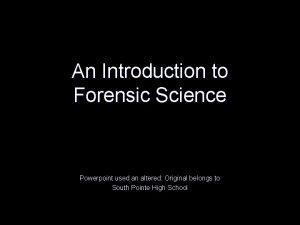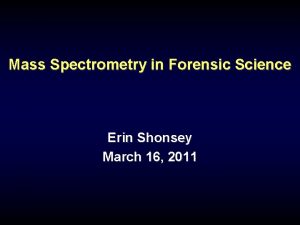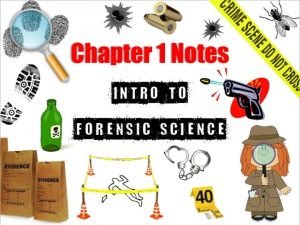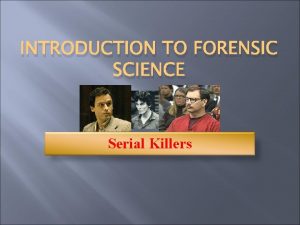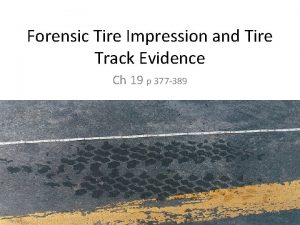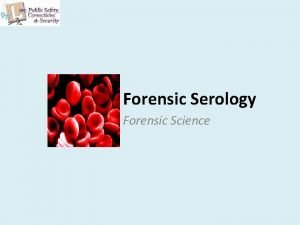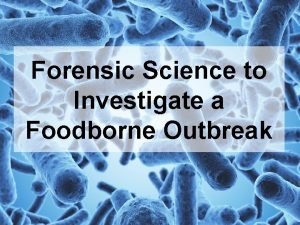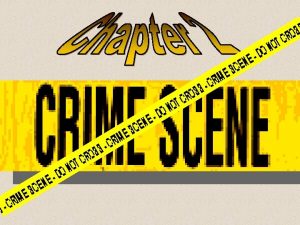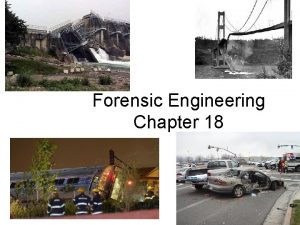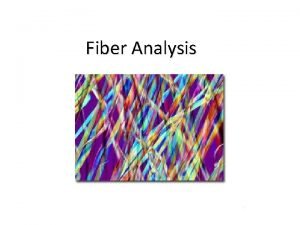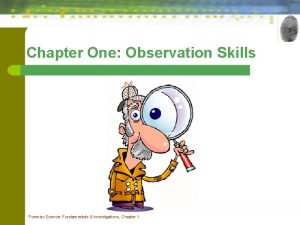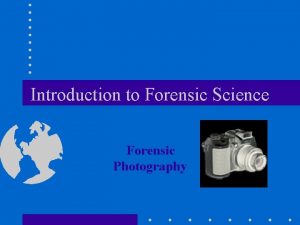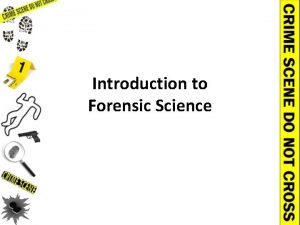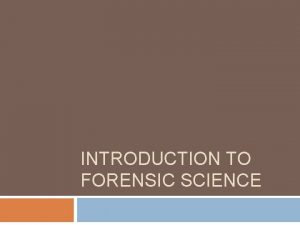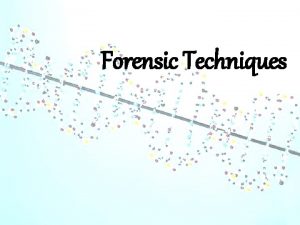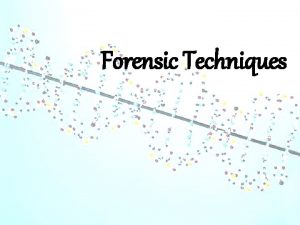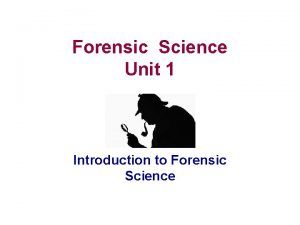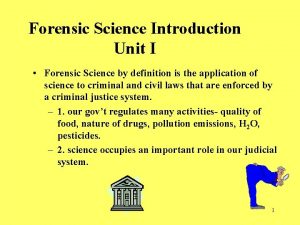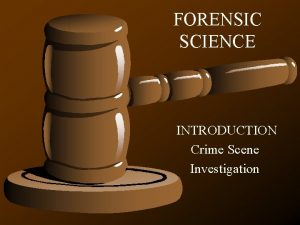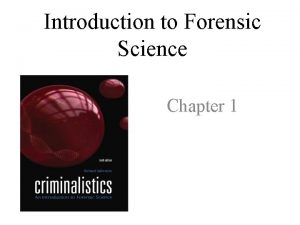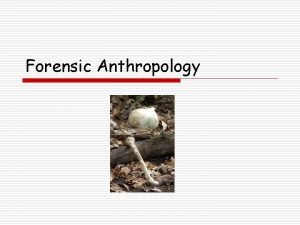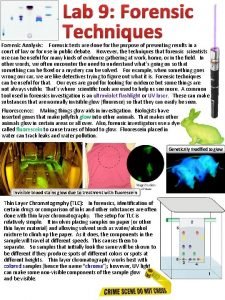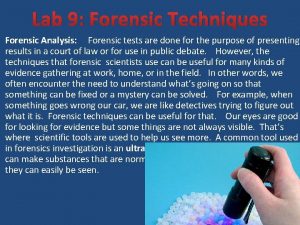An Introduction to Forensic Science What is Forensic






















- Slides: 22

An Introduction to Forensic Science

What is Forensic Science? • Forensic science is the study and application of science to matters of law. • You can use the terms forensic science and criminalistics interchangeably.

Forensic Science defined: • Forensic Science (or Criminalistics) is the use of science & technology to enforce civil & criminal laws. • It is vague & hard to define b/c it includes so many other areas of science.

Civil vs. Criminal Law CIVIL LAW CRIMINAL LAW filed by a private party. o a corporation o an individual person filed by the government Penalty: a guilty defendant pays the plaintiff for losses caused by their actions. o no incarceration Penalty: a guilty defendant is punished by o incarceration (in jail/prison) o fine paid to the gov’t o execution (death penalty) Crimes are divided into 2 classes: o misdemeanors - less than 1 year incarceration o felonies - sentence of 1+ year

History & Development of Forensic Science

When in Rome… • “Forensic” comes from the Latin word “forensis” meaning forum. • During the time of the Romans, a criminal charge meant presenting the case before the public. • Both the person accused of the crime & the accuser would give speeches based on their side of the story. • The individual with the best argumentation would determine the outcome of the case.

Sir Arthur Conan Doyle • Sci-fi author in late 1800’s • Popularized scientific crime-detection methods through his fictional character ‘Sherlock Holmes’.

Mathieu Orfila (1787 -1853) • “Father of Toxicology” • Wrote about the detection of poisons & their effects on animals.

Alphonse Bertillon (1853 -1914) • “Father of Anthropometry” • Developed a system to distinguish one individual person from another based on certain body measurements.

Francis Galton (1822 -1911) • “Father of Fingerprinting” • Developed fingerprinting as a way to uniquely identify individuals.

Leone Lattes (1887 -1954) • “Father of Bloodstain Identification” • He developed a procedure for determining the blood type (A, B, AB, or O) of a dried blood stain.

Calvin Goddard (1891 -1955) • “Father of Ballistics” • Developed the technique to examine bullets, using a comparison microscope, to determine whether or not a particular gun fired the bullets.

Albert Osborn (1858 -1946) • “Father of Document Examination” • His work led to the acceptance of documents as scientific evidence by the courts.

Walter Mc. Crone (1916 -2002) • “Father of Microscopic Forensics” • He developed & applied his microscope techniques to examine evidence in countless court cases.

Hans Gross (1847 -1915) “Father of Forensic Publications” Wrote the book on applying all the different science disciplines to the field of criminal investigation.

Edmond Locard (1877 -1966) • “Father of the Crime Lab” • In 1910, he started the 1 st crime lab in an attic of a police station. • With few tools, he quickly became known world-wide to forensic scientists & criminal investigators & eventually founded the Institute of Criminalistics in France. • His most important contribution was the “Locard’s Exchange Principle”

Locard’s Exchange Principle • “Every Contact Leaves a Trace. ” • He believed that every criminal can be connected to a crime by particles carried from the crime scene. • When a criminal comes in contact with an object or person, a crosstransfer of evidence occurs.

J. Edgar Hoover • “Father of the FBI” - Director of Federal Bureau of Investigation during the 1930’s • Hoover's leadership spanned 48 yrs & 8 presidential administrations. His reign covered Prohibition, the Great Depression, WWII, the Korean War, the Cold War, & the Vietnam War. • He organized a national laboratory to offer forensic services to all law enforcement agencies in the U. S.

The Trial of the Century O. J. Simpson was a NFL football legend. He is now famous for having been tried for the murder of ex-wife Nicole Brown Simpson & her friend Ronald Goldman in 1994. He was acquitted in criminal court after a lengthy, highly publicized trial.

What went wrong? • 1 st on the scene, police found evidence of blood & entered the Simpson home without a search warrant, an action permissible b/c the situation was an emergency. • HOWEVER, the police collected a pair of bloodstained gloves during their search. • Collection of evidence without proper warrants became the key argument used by Simpson’s legal team & ultimately led to his acquittal.

What was learned? If forensic evidence is to be admissible in court, the highest professional standards must be used at the crime scene!

Summary: • Romans-trial format • Sir Arthur Conan Doyle-popularized forensics • Matheiu Orfilia-Toxicology • Alphonse Bertillon-first system of personal identification • Francis Galton-Fingerprints • Leone Lattes-Bloodstains • Calvin Goddard-Ballistics • Albert Osborne-Documents • Walter Mc. Crone-Microscope procedures • Hans Gross-First textbook • Edmond Locard-Locard’s Exchange Principle • J. Edgar Hoover-FBI • OJ Simpson Trial-Crime science procedures and protocol
 Forensic science powerpoint
Forensic science powerpoint Forensic science unit
Forensic science unit Forensic science an introduction
Forensic science an introduction Chapter 1 intro to forensic science
Chapter 1 intro to forensic science What's your subject
What's your subject Forensic anthropologist vs forensic pathologist
Forensic anthropologist vs forensic pathologist Forensic psychiatry vs forensic psychology
Forensic psychiatry vs forensic psychology K5 think central
K5 think central Hegar sign in pregnancy
Hegar sign in pregnancy Pigment granules in hair
Pigment granules in hair Mass spectrometry in forensic science
Mass spectrometry in forensic science Forensic branches
Forensic branches How many people did aileen wuornos kill
How many people did aileen wuornos kill Important people in forensic science
Important people in forensic science Track width definition forensics
Track width definition forensics Importance of forensic serology
Importance of forensic serology Forensic science foodborne outbreak investigation answers
Forensic science foodborne outbreak investigation answers What is forensic science definition
What is forensic science definition Where does forensic science begin
Where does forensic science begin Forensic science arson activity
Forensic science arson activity Forensic science chapter 18 review answers
Forensic science chapter 18 review answers Fiber analysis forensic science
Fiber analysis forensic science Observation definition forensics
Observation definition forensics
